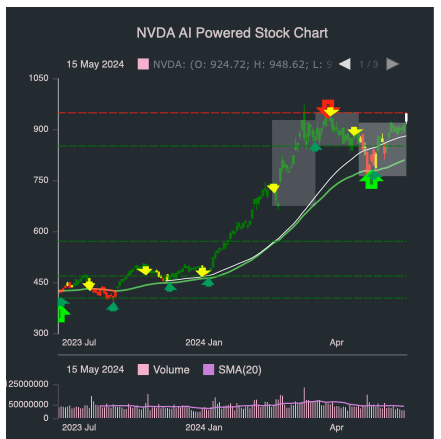20 New Reasons For Selecting AI Stock Picker Platform Sites
20 New Reasons For Selecting AI Stock Picker Platform Sites
Blog Article
Top 10 Ways To Evaluate The Security And Privacy Of Ai Stock Trading Platforms
The security and privacy of trading platforms built on AI are important, since they handle financial and personal information. An unauthorized breach of data or misuse of data can result in financial losses and reputational damage. Here are the top 10 suggestions for assessing the security and security of these platforms:
1. Consider Data Encryption
Secure transmission of data: Make sure whether the application you're using has secure protocols that secure your data when it is transmitted between their servers and your device (e.g. TLS/SSL).
Transporting encrypted data Verify that the sensitive data stored on the server has been encrypted using strong encryption standards such as AES-256.
End-to-end encryption: Check whether your platform offers encryption from beginning to end for data and communications that are considered to be sensitive.
2. Test the Authentication Measures
Two-factor authentication (also known as copyright) is an excellent way to increase security.
Verify biometric authentication.
Password policies: Check if the platform enforces strict password policies (e.g. minimum length or requirements for complexity).
3. Check for regulatory compliance
Financial regulations: Make sure the platform is compliant with pertinent financial regulations (e.g., SEC, FINRA, MiFID II).
Data protection law: If your business is with or reside in the region legally governed by these laws, ensure compliance.
Audit certifications. Verify that the platform you are considering has been through third-party assessments of security or certifications.
Review Data Access Controls
Role based access: Use accessibility rules based on roles to limit access to data only to authentic users.
Check if you are able to assign permissions on a granular level for different users and team members.
Activity monitoring. Check whether your platform keeps track of and monitors user's activities.
5. Examine Vulnerability Management
Regular updates: Ensure that your platform is updated regularly its software to patch security holes.
Make sure that the platform is regularly subjected for penetration testing in order to find security weaknesses and correct them.
Programs for bug bounty: Check whether the platform has a bug bounty program to encourage security researchers from outside to identify vulnerabilities.
6. Evaluate Data Privacy Policies
Transparency: Go through the privacy policies on the platform to learn how your information is used, gathered and shared.
Data minimization: Ensure the platform only collects the information necessary to run the platform.
Third-party sharing : Check the platform's data sharing policies and terms.
7. Secure API Utilization is Verified
API security - Make sure that the API of your application uses secure authentication methods such as OAuth or API keys, and also encrypts any data exchanges.
Rate limiting: Verify if the API has rate limits in order to stop brute-force attacks or abuse.
Review the access logs and check if they're recorded for monitoring and auditing.
8. Assess the Recovery and Response to Incidents
Incident Response Plan: Ensure that your platform has a well-defined incident response procedure for handling data breaches.
Check the platform's notification policies to see if it notifies users in a timely manner when there's an attack on security.
Backups of data: Make sure that the platform regularly backs up its data frequently and has an emergency recovery plan.
9. Review physical security measures
Security of the data center - Make sure that the platform's server is located in secure data centers with physical security (e.g. surveillance, access control).
Redundancy Verify that the platform is using redundant systems to store data in case hardware failures.
Geographic distribution: To improve resilience, make sure that the data is distributed to multiple locations.
10. Test the privacy controls of your users
Data deletion. Make sure you can permanently delete data from the platform when you stop utilizing the service.
Privacy settings: Check if the platform provides privacy settings that control the data that is public or shared.
Check for anonymization. This is essential when you use the platform for analysis or machine-learning.
Bonus Tips
Feedback and reviews from users Reviews and feedback from users to judge the reputation of a website in terms of security and privacy.
Free trial period: Test the privacy and security features using a demo.
Customer Support: Make sure that the platform is able to provide robust support for security issues.
You can test the privacy, security, and accuracy of AI platforms for trading stocks by following these suggestions. This ensures that your financial information and personal data are safe. Secure platforms will not only safeguard your investments, but will also build confidence and trust in its service. View the best recommended you read about trading ai for website advice including best ai trading software, best ai stock trading bot free, best ai trading app, best ai trading app, ai for trading, ai stock trading bot free, investment ai, ai stock trading bot free, stock ai, ai for investing and more.
Top 10 Tips On Risk Management Of Ai Trading Platforms That Forecast Or Analyze Stock Prices
Any AI trading platform that predicts or analyzes stocks has to have risk management in place that is crucial to safeguard your capital and minimizing losses. A platform with robust risk management tools can aid you in managing uncertain markets, and make educated choices. Below are the top ten tips to assess the risk management capabilities of these platforms.
1. Evaluate Stop-Loss and Take-Profit Features
Customizable settings: Make sure you can set the maximum take-profit and stop-loss levels for certain trades.
Check if you can use trailing stops. They will automatically adjust if market conditions shift in your favor.
Guaranteed stops: Check whether the broker offers guarantees on stop-loss orders that ensure your position is closed at the exact price even in markets that are volatile.
2. Effective Tools to Assess Position Size
Fixed amount: Make sure that the platform lets you establish the size of a position based upon an amount that is fixed in monetary terms.
Percentage: See whether you are able to determine your positions' sizes in proportion to the value of your portfolio. This will enable you to control risk more effectively.
Risk-reward Ratio: Make sure that the platform permits setting individual risk-reward levels.
3. Look for Diversification Aid
Multi-asset trading : Ensure that the platform you choose to use allows you to trade across different asset classes, such as stocks, ETFs and options. This can help you diversify your portfolio.
Sector allocation: Ensure that the platform is equipped with tools for monitoring exposure to different sectors.
Geographic diversification. Check if the platform can trade on international markets that spread geographical risk.
4. Review the margin and leverage controls
Margin requirements: Ensure the platform clearly outlines the margin requirements for trading leveraged.
Limits on leverage: Find out whether the platform permits you to set leverage limits to limit risk exposure.
Margin calls: Ensure that you are receiving prompt notifications from the platform in order to ensure that your account is not liquidated.
5. Assessment and Reporting of Risk
Risk metrics - Check that your platform has crucial risk metrics, such as the Sharpe ratio (or Value at Risk (VaR)), or drawdown (or value of the portfolio).
Analysis of scenarios: See if the platform allows you to model various market scenarios in order to evaluate possible risks.
Performance reports: Verify if the platform provides complete performance reports, including the risk-adjusted return.
6. Check for Real-Time Risk Monitoring
Portfolio monitoring - Ensure that the platform you select provides real-time monitoring so that your portfolio is protected.
Alerts and notifications - Verify that the platform sends out real-time alerts when risks occur (e.g. margin breaches or triggers for stop-loss order).
Risk dashboards: Ensure the platform provides customized risk dashboards that give you a full picture of your personal profile.
7. How to evaluate the results of Stress Testing and Backtesting
Stress testing: Ensure the platform lets you stress test your portfolio or strategies under the most extreme market conditions.
Backtesting: Make sure that the platform allows backtesting strategies that are based on historical data in order to evaluate risk and performance.
Monte Carlo Simulations: Check whether the application uses Monte Carlo simulations in order to analyze and predict the possible results.
8. Risk Management Regulations: Assess compliance
Check that the platform satisfies the regulatory compliance requirements (e.g. MiFID II regulations in Europe, Reg T regulations in the U.S.).
Best execution : Check to find out if your platform uses the most efficient execution methods. This guarantees that trades are executed at the most efficient price, minimising slippage.
Transparency. Verify that the platform is transparent and provides clear disclosures about the risks.
9. Check for Risk Parameters that are User Controlled
Customized risk rules: Make sure that your platform allows you set up your own risk management rules (e.g. maximum daily loss or maximum position size).
Automated risk control: Determine whether the system can automatically enforce rules for risk management in accordance with the parameters you've set.
Check whether the platform permits manual overrides for automated risk control.
Study Case Studies, User Feedback, and Case Studies
User reviews: Read feedback from users to assess the effectiveness of the platform in managing risk.
Testimonials or case studies should be used to highlight the platform's capabilities to manage risks.
Community forums - Look to see if the platform provides a user-friendly community that is active and where traders are able to share their risk management strategies.
Bonus Tips
Trial period: Use an unpaid trial or demo to try out the features of the platform for risk management in real-world situations.
Customer support: Make sure your platform has a robust assistance for any questions or issues that are related to the management of risk.
Educational resources: Find out whether the platform offers educational resources or tutorials regarding risk management best practices.
Following these tips can aid you in evaluating the risks management options that are offered by AI platform for predicting or analyzing stocks. You'll be able to pick a platform that can ensure your capital is protected while minimizing potential losses. Tools for managing risk that are robust are crucial for trading on unstable markets. Read the top this hyperlink about ai trading tool for more tips including ai stock trader, best ai stocks to buy now, investing with ai, ai stock predictions, stock predictor, ai copyright signals, how to use ai for copyright trading, ai stock trader, chart analysis ai, ai stock investing and more.